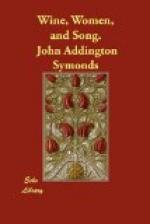The wide space occupied by Nature in the secular poems of the Goliardi is remarkable. As a background to their love-songs we always find the woods and fields of May, abundant flowers and gushing rivulets, lime-trees and pines and olive-trees, through which soft winds are blowing. There are rose-bowers and nightingales; fauns, nymphs, and satyrs dancing on the sward. Choirs of mortal maidens emerge in the midst of this Claude-landscape. The scene, meanwhile, has been painted from experience, and felt with the enthusiasm of affection. It breathes of healthy open air, of life upon the road, of casual joys and wayside pleasure, snatched with careless heart by men whose tastes are natural. There is very little of the alcove or the closet in this verse; and the touch upon the world is so infantine, so tender, that we are indulgent to the generalities with which the poets deal.
What has been said about popular poetry applies also to popular painting. In the landscapes of Goliardic literature there is nothing specific to a single locality—no name like Vaucluse, no pregnant touch that indicates one scene selected from a thousand. The landscape is always a background, more northern or more southern as the case may be, but penetrated with the feeling of the man who has been happy or has suffered there. This feeling, broadly, sensuously diffused, as in a masterpiece of Titian, prepares us for the human element to be exhibited.
The foreground of these pictures is occupied by a pair of lovers meeting after the long winter’s separation, a dance upon the village green, a young man gazing on the mistress he adores, a disconsolate exile from his home, the courtship of a student and a rustic beauty, or perhaps the grieved and melancholy figure of one whose sweetheart has proved faithless. Such actors in the comedy of life are defined with fervent intensity of touch against the leafy vistas of the scene. The lyrical cry emerges clear and sharp in all that concerns their humanity.
The quality of love expressed is far from being either platonic or chivalrous. It is love of the sensuous, impulsive, appetitive kind, to which we give the name of Pagan. The finest outbursts of passion are emanations from a potent sexual desire. Meanwhile, nothing indicates the character or moral quality of either man or woman. The student and the girl are always vis-a-vis, fixed characters in this lyrical love-drama. He calls her Phyllis, Flora, Lydia, Glycerion, Caecilia. He remains unnamed, his physical emotion sufficing for personal description. The divinity presiding over them is Venus. Jove and Danae, Cupid and the Graces, Paris and Helen, follow in her train. All the current classical mythology is laid under cheap contribution. Yet the central emotion, the young man’s heart’s desire, is so vividly portrayed, that we seem to be overhearing the triumphant ebullition or the melancholy love-lament of a real soul.




